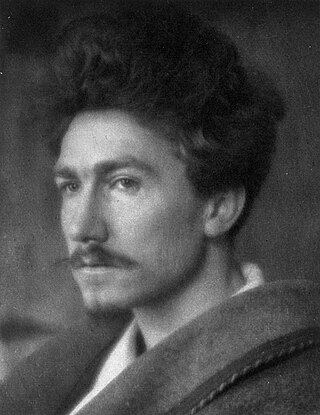
An ideogram or ideograph is a graphic symbol that represents an idea or concept, independent of any particular language, and specific words or phrases. Some ideograms are comprehensible only by familiarity with prior convention; others convey their meaning through pictorial resemblance to a physical object, and thus may also be referred to as pictograms.

Ezra Weston Loomis Pound was an expatriate American poet and critic, a major figure in the early modernist poetry movement, and a fascist collaborator in Italy during World War II. His works include Ripostes (1912), Hugh Selwyn Mauberley (1920), and his 800-page epic poem, The Cantos (c. 1917–1962).

Imagism was a movement in early-20th-century Anglo-American poetry that favored precision of imagery and clear, sharp language. It is considered to be the first organized modernist literary movement in the English language. Imagism is sometimes viewed as "a succession of creative moments" rather than a continuous or sustained period of development. The French academic René Taupin remarked that "it is more accurate to consider Imagism not as a doctrine, nor even as a poetic school, but as the association of a few poets who were for a certain time in agreement on a small number of important principles".

Hilda Doolittle was an American modernist poet, novelist, and memoirist who wrote under the name H.D. throughout her life. Her career began in 1911 after she moved to London and co-founded the avant-garde Imagist group of poets with American expatriate poet and critic Ezra Pound. During this early period, her minimalist free verse poems depicting Classical motifs drew international attention. Eventually distancing herself from the Imagist movement, she experimented with a wider variety of forms, including fiction, memoir, and verse drama. Profoundly affected by her experiences in London during the Blitz, H.D.'s poetic style from World War II until her death pivoted towards complex long poems on esoteric and pacifist themes.
Modernist poetry in English started in the early years of the 20th century with the appearance of the Imagists. In common with many other modernists, these poets wrote in reaction to the perceived excesses of Victorian poetry, with its emphasis on traditional formalism and ornate diction. In many respects, their criticism echoes what William Wordsworth wrote in Preface to Lyrical Ballads to instigate the Romantic movement in British poetry over a century earlier, criticising the gauche and pompous school which then pervaded, and seeking to bring poetry to the layman.
"In a Station of the Metro" is an Imagist poem by Ezra Pound published in April 1913 in the literary magazine Poetry. In the poem, Pound describes a moment in the underground metro station in Paris in 1912; he suggested that the faces of the individuals in the metro were best put into a poem not with a description but with an "equation". Because of the treatment of the subject's appearance by way of the poem's own visuality, it is considered a quintessential Imagist text.
In book publishing, an anthology is a collection of literary works chosen by the compiler; it may be a collection of plays, poems, short stories, songs or excerpts by different authors.
The Objectivist poets were a loose-knit group of second-generation Modernists who emerged in the 1930s. They were mainly American and were influenced by, among others, Ezra Pound and William Carlos Williams. The basic tenets of objectivist poetics as defined by Louis Zukofsky were to treat the poem as an object, and to emphasize sincerity, intelligence, and the poet's ability to look clearly at the world. While the name of the group is similar to Ayn Rand's school of philosophy, the two movements are not affiliated.

Ernest Francisco Fenollosa was an American art historian of Japanese art, professor of philosophy and political economy at Tokyo Imperial University. An important educator during the modernization of Japan during the Meiji Era, Fenollosa was an enthusiastic Orientalist who did much to preserve traditional Japanese art.

Thomas Ernest Hulme was an English critic and poet who, through his writings on art, literature and politics, had a notable influence upon modernism. He was an aesthetic philosopher and the 'father of imagism'.
Frank Stuart Flint was an English poet and translator who was a prominent member of the Imagist group. Ford Madox Ford called him "one of the greatest men and one of the beautiful spirits of the country".
Modernist poetry refers to poetry written between 1890 and 1950 in the tradition of modernist literature, but the dates of the term depend upon a number of factors, including the nation of origin, the particular school in question, and the biases of the critic setting the dates. The critic/poet C. H. Sisson observed in his essay Poetry and Sincerity that "Modernity has been going on for a long time. Not within living memory has there ever been a day when young writers were not coming up, in a threat of iconoclasm."

The Cantos by Ezra Pound is a long, incomplete poem in 120 sections, each of which is a canto. Most of it was written between 1915 and 1962, although much of the early work was abandoned and the early cantos, as finally published, date from 1922 onwards. It is a book-length work, widely considered to present formidable difficulties to the reader. Strong claims have been made for it as the most significant work of modernist poetry of the twentieth century. As in Pound's prose writing, the themes of economics, governance and culture are integral to its content.
All Chinese characters are logograms, but several different types can be identified, based on the manner in which they are formed or derived. There are a handful which derive from pictographs and a number which are ideographic in origin, including compound ideographs, but the vast majority originated as phono-semantic compounds. The other categories in the traditional system of classification are rebus or phonetic loan characters and "derivative cognates". Modern scholars have proposed various revised systems, rejecting some of the traditional categories.
Ezra Pound distinguished three aspects of poetry: melopoeia,phanopoeia, and logopoeia.

"The Parable of the Sunfish" is an anecdote with which Ezra Pound opens ABC of Reading, a 1934 work of literary criticism. Pound uses this anecdote to emphasize an empirical approach for learning about art, in contrast to relying on commentary rooted in abstraction. While the parable is based on students' recollections of Louis Agassiz's teaching style, Pound's retelling diverges from these sources in several respects. The parable has been used to illustrate the benefits of scientific thinking, but more recent literary criticism has split on whether the parable accurately reflects the scientific process and calls into question Pound's empirical approach to literature.

Cathay (1915) is a collection of classical Chinese poetry translated into English by modernist poet Ezra Pound based on Ernest Fenollosa's notes that came into Pound's possession in 1913. At first Pound used the notes to translate Noh plays and then to translate Chinese poetry to English, despite a complete lack of knowledge of the Chinese language. The volume's 15 poems are seen less as strict translations and more as new pieces in their own right; and, in his bold translations of works from a language he was unfamiliar with, Pound set the stage for modernist translations.

Jonathan Stalling is an American poet, scholar, editor, translator, professor, and inventor who works at the intersection of English and Chinese. He is the Harold J & Ruth Newman Chair for US-China Issues and co-director of the Institute for US-China Issues, and is Professor of International and Area Studies at the University of Oklahoma. He is also the affiliate English professor at the University of Oklahoma where he serves as the founding curator of the Chinese Literature Translation Archive (CLTA), and as a founding editor of Chinese Literature Today (CLT) journal and as the editor of the CLT and CLT book series published by the University of Oklahoma Press. He is the creator of the English Jueju poetic form and Directs the Newman Prize for Chinese Literature and Newman Prize for English Jueju.
David Happell Hsin-fu Wand (1931–1977) was a poet, translator, collaborator with William Carlos Williams and Ezra Pound, and editor responsible for the popularization of Asian-American literature through his 1974 anthology Asian American Heritage: An Anthology of Prose and Poetry. After espousing virulently neo-fascistic and segregationist views in the 1950s under the tutelage of Pound, Wand moved to California in the 60s and became a supporter of the Black Power movement, seeing parallels between the Asian-American and African-American experience.

Reading Pound Reading: Modernism After Nietzsche is a 1987 book on Ezra Pound by the literary scholar and professor Kathryne V. Lindberg. Lindberg considers the influence of Nietzsche upon the prose criticism of Ezra Pound, including his essay "How to Read," his books The ABC of Reading and Guide to Kulchur, as well as in more ephemeral and fugitive sources such as newspapers and obscure literary journals.









